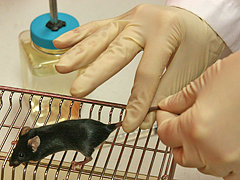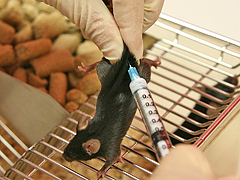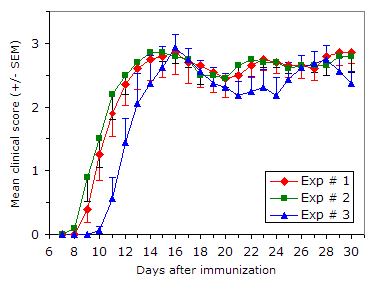EAE Induction by Active Immunization in C57BL/6 Mice
Please note: This protocol was for use with discontinued products. This protocol is provided for historical reference only.
All customers are encouraged to switch to the latest products for this application.
There are no advantages to the discontinued products.
Recommended protocol for use with:
- Hooke Kit™ MOG35-55/CFA Emulsion PTX (EK-0110, EK-0112, EK-0113, EK-0114, EK-0115, or EK-0116), or,
- Hooke Kit™ MOG1-125/CFA Emulsion PTX (EK-0162 or EK-0164)
Summary
C57BL/6 mice develop chronic paralysis after immunization with MOG35-55 or MOG1-125 emulsified in Complete Freund's Adjuvant (CFA). Mice develop EAE 8-14 days after immunization and stay chronically paralyzed for the duration of the experiment (typically, mice are observed for 30-40 days).
Around 25% of the mice show exacerbation of EAE symptoms after initial partial recovery. This usually occurs 20-27 days after immunization.
Background biology
The kit consists of two components, each delivered in separate pre-filled syringes – antigen (MOG35-55 or MOG1-125) in CFA emulsion, and pertussis toxin (PTX) in PBS.
The emulsion provides antigen needed to expand and differentiate MOG-specific autoimmune T cells. Tissue dendritic cells pick up the antigen and take it to the draining lymph nodes, where priming of T cells takes place.
Pertussis toxin enhances EAE development by providing additional adjuvant. PTX injection affects cell trafficking, development of Th17 cells and integrity of the blood-brain barrier.
It is not clear which of these effects influence EAE development.
Kit selection
| Cat # | EK-0113 | EK-0110 | EK-0112 | EK-0114 | EK-0115 | EK-0116 | EK-0162 | EK-0164 |
|---|---|---|---|---|---|---|---|---|
| Antigen | MOG35-55 | MOG35-55 | MOG35-55 | MOG35-55 | MOG35-55 | MOG35-55 | MOG1-125 | MOG1-125 |
| PTX dose | 1x | 1.5x | 2.5x | 3.75x | 5x | 7x | 2.5x | 3.75x |
Hooke Kits™ containing MOG35-55 antigen are recommended for study of onset and development of EAE. Hooke Kits™ containing MOG1-125 are recommended for testing therapeutics which target B cells. For information on choice of model and antigen, please see our Learning Center.
We recommend that customers planning to use MOG1-125 antigen titrate EAE development using our MOG35-55/CFA Emulsion PTX Hooke Kits™, and then select a MOG1-125 Hooke Kit™ based on the results as follows:
| Best EAE development with MOG35-55 |
Recommended MOG1-125 Hooke Kit™ |
|---|---|
| EK-0110 or EK-0112 | EK-0162 |
| EK-0114 or EK-0115 | EK-0164 |
Many factors influence EAE disease susceptibility and the pertussis toxin (PTX) dose required. These include mouse age, strain, breeder, and colony, as well as mouse stress. Even with identical mice and reagents, EAE disease can vary considerably from lab to lab.
Each Hooke Kit™ contains different doses of PTX. We recommend that new customers begin by running 10 mice with our Hooke Kit™ EK-0114. We can recommend the best Hooke Kit™ for you based on the EAE incidence and average severity in these mice. After running 10 mice with EK-0114 you can move to a weaker or stronger kit if necessary, depending on results.
With a given Hooke Kit™, older mice generally develop more severe disease and more uniform disease onset.
Materials needed
| Qty | Description |
|---|---|
| 1 | Hooke Kit™ MOG35-55/CFA Emulsion PTX (EK-0110, EK-0112, EK-0113, EK-0114, EK-0115, or EK-0116) or Hooke Kit™ MOG1-125/CFA Emulsion PTX (EK-0162 or EK-0164) |
| 10 | C57BL/6 mice, females At least 9 weeks old (10 weeks or older recommended) (Taconic Biosciences model B6-F or Jackson Laboratory strain C57BL/6J) |
Preparation
Minimizing mouse stress is very important to successful EAE induction – stress reduces EAE susceptibility in mice.
Mice should be housed in a quiet environment, without excessive noise or vibration. Static cages are preferred to some ventilated cages; airflow in some types of ventilated cages may increase mouse stress.
It is best to perform all procedures in the mouse room, instead of moving mice to a separate procedure room. Moving mice on carts contributes to stress.
Avoid excessive handling of mice; handle mice gently at all times.
Use of anesthesia is not necessary or recommended. If anesthesia must be used per veterinary requirements, we recommend inhaled anesthesia to minimize stress.





Method
Mice should be acclimated at your facility for at least 7 days before immunization.
Subcutaneous injection technique is important to successful EAE induction. (These procedures are drafted for right-handed injection; reverse if injecting with the left hand.)
-
Grip mouse tail with finger and thumb of right hand (figure).
-
Restrain mouse against cage with three remaining fingers of right hand (figure).
-
With left hand, restrain mouse with two fingers behind head (figure).
-
Using right hand, inject mouse subcutaneously on upper back with 0.1 mL of emulsion (syringe with white content; figure).
Keep the needle inserted into the subcutaneous space for 10 to 15 seconds to avoid leakage of the emulsion. Alternatively, a light pull on the syringe plunger will prevent leakage.
-
Using a similar technique, inject mouse subcutaneously on lower back with 0.1 mL of emulsion (figure).
Again, keep the needle inserted into the subcutaneous space for 10 to 15 seconds or lightly pull on the syringe to avoid leakage.
Repeat (1–5) for all mice.
-
Within 2 hours of injection of the emulsion, intraperitoneally inject the first dose of pertussis toxin (syringe with clear content). Inject 0.1 mL per mouse.
-
22-26 hours after injection of the emulsion, intraperitoneally inject the second dose of pertussis toxin into the mice; inject 0.1 mL of pertussis toxin (syringe with clear filling) into each mouse.
-
Check mice for signs of EAE daily (see EAE scoring), starting on day 7 after the immunization.
-
As soon as the first signs of paralysis occur, provide mice with food pellets and wet food on the floor of the cage, and easily accessible water. HydroGel (ClearH2O, Portland ME) may be used as a source of water during the most severe paralysis.
All mice will develop obvious bumps of emulsion at the injection sites 2 to 4 days after injection.
In some mice, alopecia will develop at the site of injection 5 to 7 days after injection.
In most mice, the emulsion will remain at the site of injection for the duration of the experiment (~30 days). Approximately 10% to 40% of the mice will clear the emulsion by developing skin ulcers at injection sites. Most of the time, these ulcers do not require treatment – they usually heal in a few days and scars form. If concerned, consult attending veterinarian. Antibiotic ointment may be applied.
EAE development does not correlate with mice clearing or not clearing emulsion from the injection site.
EAE Scoring
Typically, EAE is scored on scale 0 to 5:
| Score | Clinical observations |
|---|---|
| 0 |
No obvious changes in motor functions of the mouse in comparison to
non-immunized mice. When picked up by the tail, the tail has tension and is erect. Hind legs are usually spread apart. When the mouse is walking, there is no gait or head tilting. |
| 1 | Limp tail. When the mouse is picked up by the tail, instead of being erect, the whole tail drapes over your finger. |
| 2 | Limp tail and weakness of hind legs. When mouse is picked up by tail, legs are not spread apart, but held closer together. When the mouse is observed when walking, it has a clearly apparent wobbly walk. |
| 3 | Limp tail and complete paralysis of hind legs (most common). OR Limp tail with paralysis of one front and one hind leg. OR ALL of:
|
| 4 |
Limp tail, complete hind leg and partial front leg paralysis. Mouse is minimally moving around the cage but appears alert and feeding. Usually, euthanasia is recommended after the mouse scores level 4 for 2 days. When the mouse is euthanized because of severe paralysis, score of 5 is entered for that mouse for the rest of the experiment. |
| 5 | Complete hind and complete front leg paralysis, no movement around
the cage. OR Mouse is spontaneously rolling in the cage. OR Mouse is found dead due to paralysis. If mouse is alive, euthanize the mouse immediately if it scores 5. Once mouse is scored 5, the same score is entered for all the days for the rest of the experiment. |
Most researchers also give mice “in-between” scores (i.e. 0.5, 1.5, 2.5, 3.5) when the clinical picture lies between two defined scores.
Expected results
EAE will be consistently induced in 90-100% of the mice, with onset of paralysis between 8 and 14 days after immunization, and mean maximum score of 2-3.
Daily dosing of mice with a potential therapeutic often delays the onset of EAE and decreases severity of EAE due to stress of the procedures. Careful handling of the mice will minimize these effects. To reduce effects of stress, we recommend sham dosing, 7 and 4 days before immunization of the mice.
The following illustrates typical results:

EAE induction in C57BL/6 mice
Protocol: EAE Induction by Active Immunization in C57BL/6 Mice
Data are from three independent experiments using Hooke Kit™ MOG35-55/CFA Emulsion PTX (EK-0110), with Taconic mice.
Similar results are obtained using other MOG35-55/CFA Emulsion PTX Hooke Kits™, and with MOG1-125/CFA Emulsion PTX Hooke Kits™, using the recommended protocol.
| Exp # | Mice/group | Age at immunization |
Mean maximum score ± SD |
Day of onset ± SD |
Disease incidence |
|---|---|---|---|---|---|
| 1 | 10 | 10 weeks | 3.25 ± 0.49 | 10.9 ± 3.9 | 100 % |
| 2 | 10 | 10 weeks | 3.45 ± 0.60 | 10.1 ± 1.5 | 100 % |
| 3 | 8 | 9 weeks | 3.25 ± 0.38 | 12.1 ± 1.6 | 100 % |
Troubleshooting
Successful induction of EAE requires low-stress mouse handling and husbandry procedures, good injection technique (as recommended above), use of appropriate mice, and good quality, stable, antigen emulsion together with the correct amount of pertussis toxin.
If you have difficulty inducing EAE, check the following:
- Mice should be acclimated for 7 days to your lab before starting.
- Use female mice at no younger than 9 weeks old. (10 weeks or older recommended.)
- Follow recommended injection procedure (see above).
- Avoid excessive noise or vibration.
- Avoid excessive handling of mice. Handle mice gently.
- Try to do all procedures in the mouse room. Avoid moving mice on carts.
- Static cages are preferred to (some) ventilated cages.
- Avoid use of anesthesia if possible. If anesthesia must be used, we recommend inhaled anesthesia.
References
Mendel I et al, Eur J Immunol 25:1951 (1995)
Marusic S et al, J Exp Med 202:841 (2005)
Thakker P et al, J Immunol 178:2589 (2007)
Version: 2012-07


_150px.jpg)